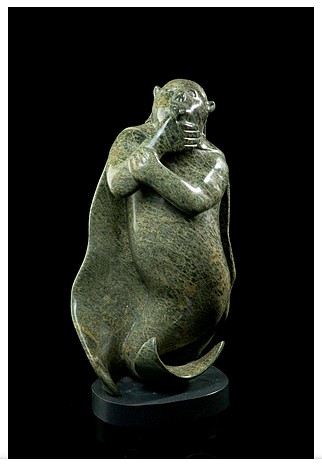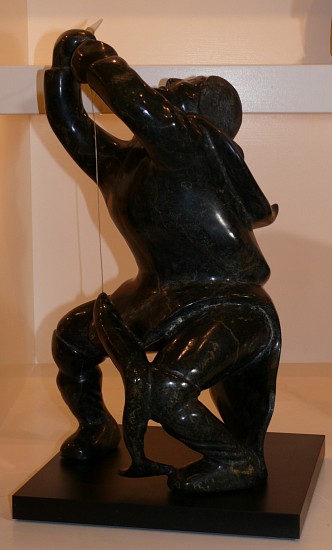Qavaroak Tunnillie






Qavaroak Tunnillie, Sedna, 1980s
Stone, 20 1/2 x 11 x 9 in. (52.1 x 27.9 x 22.9 cm)
Qavaroak Tunnillie was one of the greatest first-generation Cape Dorset carvers. His carvings were exceptionally dynamic and fully realized in the round (as opposed to the many carvings that were made to be viewed only from the front). This Sedna is exceptional in many ways. Sedna, the ruling spirit of the seas, controlled the marine mammals and fish, and thus much of the Inuit's food supply. Traditionally, sedna was depicted with amputated fingers. (For the legend of Sedna, see https://www.alaskaonmadison.com/exhibition/3/press_release/ ). This carving shows Sedna with amputated fingers on her left hand, but with complete fingers on the right hand. In addition, Sedna is shown here wearing a long, flowing cape, an uncommon garment among the Inuit. Finally, instead of Sedna's traditional long braids, her hair has been cut short. We can only speculate about the variant of the Sedna legend that the artist based this enigmatic work on.
03557-1










Qavaroak Tunnillie, Woman catching fish
Stone, sinew, antler, 19 x 9 x 8 in.
This is a superb example of Qavaroak Tunnillie's work. Qavaroak was one of the finest of the first-generation Cape Dorset carvers. This woman has just caught a fish, and it is exceptional for its dynamic, fully in-the-round composition. The generous use of negative space speaks to the artist's talent, as do the flowing lines of the woman's amaut and the vibrant, leaping fish. The woman holds a fishing jig (which is a reconstruction), and has just landed the fish. This excellent National Film Board of Canada video shows Inuit jigging for fish. The catch occurs around minute 24 of the video. https://www.nfb.ca/film/jigging_for_lake_trout/
03531-1




